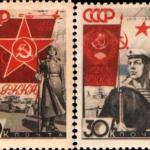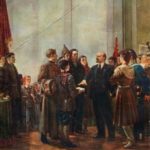Svarog (Korochkin) Vasily Semyonovich

Painting The tank takes obstacles, artist Svarog Vasily, USSR, 1931.
The founder of the Soviet newspaper illustration: Svarog (Korochkin) Vasily Semyonovich
Vasily Svarog is considered the founder of illustrations in the newspaper genre of the Soviet era. His works of art have always been executed perfectly, as a true professional, he did not tolerate hack work and constantly developed his abilities. The style of this artist’s work is closest to Ilya Repin, but this is not an imitation, but the influence of teachers who instilled in him a realistic style and a selfless love for art.

Painting Offensive in gas masks, artist Svarog V. S., USSR, 1931.
Origin of the artist
Vasily Semenovich Korochkin was born in 1883 into an ordinary peasant family. Left without a father early, he lived with his mother and sisters in a small town located in the Novgorod province. At the age of six, he was sent to a parochial school, where they noticed his rare talent for drawing, and it was his first teacher who laid his love for watercolors. Local residents, seeing the boy’s abilities, decided to support him and organized a fundraiser for education in the capital. At that time, 100 rubles was a lot of money and they were able to find them.

Shot of Aurora, artist Svarog V.S., USSR, 1931.
creative path
At the age of 13, Vasily entered the Central School of Technical Drawing of Baron A. L. Stieglitz. He studied diligently, lived with his aunt, who worked as a cook for a noble person. It was during his studies that Korochkin took a pseudonym for himself after the name of the pagan god – Svarog.
Among his teachers were well-known artists of that time, who helped in 1900 to graduate with honors. The first independent works were scenes from the life of peasants and landscapes. After that, he is fond of illustration, as a result of which, in pre-revolutionary times, he creates many posters of satirical content. His works are published by St. Petersburg magazines “The Sun of Russia”, “Picturesque Review” and many others. For the high level of his work, he even received an award at a competition organized by the Sun of Russia publishing house, held in 1911.

Guitarist, canvas, oil, artist Svarog V. S., USSR, 1940.
In 1915, the young painter met Ilya Efimovich Repin and his son Yuri. Long-term close relationship with this family had a significant impact on the style of his paintings. All works of that period, including the portrait of Yuri Repin, are housed in the Museum of the Academy of Arts. At the same time, Ilya Repin himself painted a portrait of a friend with a guitar in his hands, and another musical instrument, the piano, serves as a background, which symbolized the other side of the artist’s talent for singing and music.
Since 1916, Svarog became a member of the Association of Traveling Art Exhibitions and repeatedly received awards at their exhibitions, while presenting his works at other expositions. And the revolution unexpectedly threw him into a completely new camp of avant-gardists for him. Having accepted the changes with great enthusiasm, he is actively involved in a new life: he participates in decorating Petrograd on the anniversary of the revolution, paints portraits of its leaders, but in 1919, tired of active work, he leaves for his hometown. Here he develops amateur art activities, creates circles for children to teach singing and art. Having organized the People’s House, he even formed an opera troupe.

I. E. Repin. Portrait of the artist V. S. Svarog (1915).
He returned to Petrograd only in 1922. Here he resumes work on creating posters and actively works as an illustrator for the largest Soviet newspapers, such as Pravda, Izvestia and some other publications. At the same time, since 1924, he has been working at the Drawing School and joining the Association of Artists of Revolutionary Russia (AHRR), which promoted the simplicity and realism of painting, accessible to an ordinary person from a people with a bright political ideology. Svarog himself calls his new style “political composition”. On his canvases are portraits of famous figures, great construction projects of the young state and other scenes of political life.
Vasily Svarog was on friendly terms with Sergei Yesenin, and it was his hand that the posthumous pencil drawing belongs to, which was published in 1990 in the magazine Our Heritage. The original sketch is located in the Moscow State Museum of S. A. Yesenin.

Illustration by the artist on the cover of the Red Panorama magazine, February 4, 1927.
In the times before the Second World War, the painter was appointed head of the Studio of Military Artists, in front of which the goal was to educate the soldiers of the USSR army in a heroic spirit. The result was a series of war stories. At the same time, “for the soul”, the artist created landscapes, everyday compositions and still lifes, which he even hid from friends, while for publication he created inspiring military posters and paintings. Having left for evacuation in Tbilisi, he even managed to participate in exhibitions.

Skiers, artist Svarog V. S., USSR, 1930s.
Unfortunately, an accident at the end of 1942 put him out of action forever. Returning to the capital from emigration and crossing the railroad tracks, he stumbled and, falling, hit his head hard, he did not recover from this injury until his death. The artist died on December 31, 1946, the Novodevichy Cemetery became his resting place. But his legacy still lives on and is represented in the largest exhibition halls of the Russian Federation and other countries.

Spring. In Leningrad on the Neva embankment, artist Svarog V.S., USSR, 1927.

Self-portrait of Vasily Svarog, 1926.





